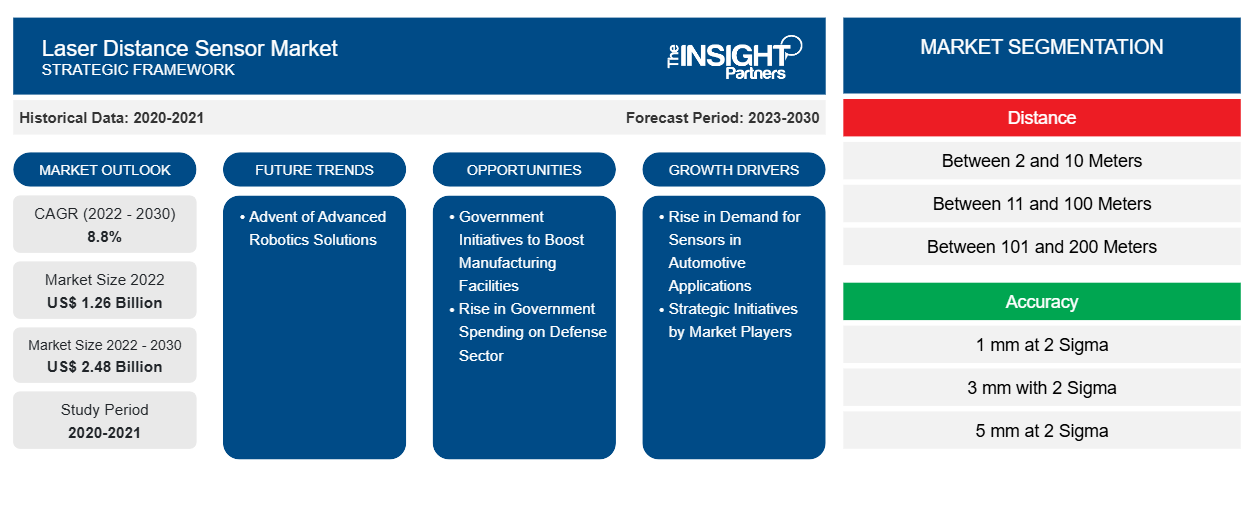[研究报告] 2022 年激光距离传感器市场规模价值 12.6 亿美元,预计到 2030 年将达到 24.8 亿美元。预计 2022 年至 2030 年激光距离传感器市场的复合年增长率为 8.8%。
分析师观点:
政府越来越重视制造设施的自动化,这产生了对激光距离传感器的需求。先进的传感应用有助于提高制造设施的运营效率。因此,政府增加投资以促进制造业发展,促进了激光距离传感器市场的增长。此外,汽车行业是激光距离传感器的主要应用之一。先进技术在汽车中的集成推动了激光距离传感器市场的发展。
激光测距传感器市场概览:
激光距离传感器是一种使用激光束计算物体之间距离的组件。这些传感器可以测量距离并允许在很远的距离进行测量。它们的工作原理是基于飞行时间 (ToF) 原理,传感器发射激光束并接收其反射。发送和接收激光束之间的时间有助于激光距离传感器确定距离。
激光距离传感器具有多种应用。例如,领先的传感器供应商 Sensor Partners 提供用于筒仓液位测量、仓库流量优化和集装箱码头船舶停泊的激光距离传感器。这些传感器可精确计算到某个物体的距离,并确保最大安全性和增强的自动化操作。此外,该公司还提供可用于因空气中存在气体和/或灰尘而存在爆炸风险的环境的传感器。
激光测距传感器市场驱动因素:
市场参与者的战略举措推动激光距离传感器市场增长
激光距离传感器提供精确的距离、间距和位置测量。它们提供精确的距离测量,使其成为 消费电子、医疗、工业、自动化和其他此类行业的理想选择。随着这些行业需求的增长,激光距离传感器市场的一些主要参与者专注于实施广泛的有机和无机增长战略,以满足多个垂直行业日益增长的需求,进一步推动激光距离传感器市场规模的增长。下面提到了其中一些增长战略:
- 2023 年 3 月,松下推出了新型激光距离传感器 HG-F,该传感器可使用 ToF(飞行时间)技术在最远 3 m 的距离内进行可靠检测。该传感器还可以安装在距离被测物体一定距离的位置,以便员工或协作机器人或机器人手臂的运动半径可以自由操作。
- 2023 年 6 月,精密传感器供应商 Micro-Epsilon 推出了一款非接触式激光距离传感器,该传感器可测量高达 270 米的距离,分辨率为 1 毫米。即使在黑暗、结构化或弱反射物体等困难环境下,该传感器也能可靠地测量。
- 2020 年 1 月,莱昂纳多将 Selex Galileo Inc. 和 Lasertel Inc. 业务合并,成立了总部位于美国的莱昂纳多电子美国公司,为医疗、国防、安全、汽车和工业领域提供下一代技术。此次收购有助于瞄准美国客户群。
定制此报告以满足您的需求
您可以免费定制任何报告,包括本报告的部分内容、国家级分析、Excel 数据包,以及为初创企业和大学提供优惠和折扣
- 获取此报告的关键市场趋势。这个免费样品将包括数据分析,从市场趋势到估计和预测。
激光距离传感器市场报告细分和范围:
激光距离传感器市场根据距离、精度、最终用户和地理位置进行细分。根据距离,激光距离传感器市场细分为 2 至 10 米、11 至 100 米、101 至 200 米和 201 至 500 米。根据精度,激光距离传感器市场细分为 2 西格玛 1 毫米、2 西格玛 3 毫米和 2 西格玛 5 毫米。根据最终用户,激光距离传感器市场细分为制造业、建筑业、汽车和机器人、航空航天和国防、地理空间行业和其他。根据地理位置,激光距离传感器市场细分为北美、欧洲、亚太地区、中东和非洲以及南美。
激光测距传感器市场细分分析:
按最终用户划分,激光距离传感器市场细分为制造业、建筑业、汽车和机器人、航空航天和国防、地理空间行业等。2022 年,汽车和机器人领域占据了最大的激光距离传感器市场份额。激光距离传感器提供精确的距离、间距和位置测量,使其适用于汽车和机器人行业的应用。这些传感器可确保更好的过程稳定性,并允许机器人进行全自动处理,而不管被测物体的属性如何。借助这些传感器,可以实现更高的效率。这些传感器与安装机器人结合使用时,还有助于精确快速地定位零件,确保无需等待即可进行处理。激光距离传感器还可用于汽车光检测和测距 (LiDAR) 系统,通过提供精确的距离测量和周围环境的 3D 映射来帮助自动驾驶。
激光测距传感器市场区域分析:
2022 年亚太激光距离传感器市场价值为 2.7709 亿美元,预计在预测期内将以 10.0% 的复合年增长率增长,到 2030 年达到 5.9424 亿美元。亚太激光距离传感器市场分为澳大利亚、中国、印度、日本、韩国和亚太其他地区。整个亚太地区的汽车行业正在经历显着增长。根据国际汽车制造商组织的数据,印度、中国、印度尼西亚、韩国和泰国等国家在 2022 年的汽车产量显着增加。此外,区域和全球汽车制造商正在投资在该地区建立新的汽车生产厂。例如,2022 年 3 月,Triton Electric Vehicle LLC 宣布在印度古吉拉特邦启动其新的生产工厂。此外,2022 年 6 月,宝马宣布在中国开设新的电动汽车生产厂,投资额为 22 亿美元。因此,汽车行业的发展需要激光距离传感器用于先进的照明系统,以实现更长距离的可见性。汽车激光距离传感器还用于高级驾驶辅助系统 (ADAS) 和其他传感要求。因此,汽车行业的不断发展促进了该地区激光距离传感器市场份额的增长。
亚太地区多个国家的政府也在计划多项举措,以支持该地区采用机器人技术。例如,2021 年 12 月,中国公布了《中国制造 2025》的改进版,这是一份产业政策蓝图。在此之下,政府发布了一项五年智能制造发展计划,旨在将该国 70% 的大型企业数字化。此外,日本政府通过投资制造业、医疗保健、基础设施和农业部门实施了新机器人战略,以整合自动化解决方案。因此,该地区的制造商专注于制造工业机器人以及升级设备和工艺。政府在各个行业引入自动化的举措产生了对光检测和测距同步定位和测绘 (Lidar SLAM) 系统中的激光距离传感器的需求。在这些系统中,激光距离传感器通过传感技术提供精确的测量结果。由于对激光距离传感器的需求不断增长,市场参与者正在推出进一步推动市场增长的解决方案。例如,2023 年 1 月,Mileseey 推出了双边激光测距仪 DP20 PRO。
激光测距传感器市场区域洞察
Insight Partners 的分析师已详细解释了预测期内影响激光距离传感器市场的区域趋势和因素。本节还讨论了北美、欧洲、亚太地区、中东和非洲以及南美和中美洲的激光距离传感器市场细分和地理位置。

- 获取激光距离传感器市场的区域特定数据
激光距离传感器市场报告范围
| 报告属性 | 细节 |
|---|---|
| 2022 年市场规模 | 12.6亿美元 |
| 2030 年市场规模 | 24.8亿美元 |
| 全球复合年增长率(2022 - 2030 年) | 8.8% |
| 史料 | 2020-2021 |
| 预测期 | 2023-2030 |
| 涵盖的领域 | 按距离
|
| 覆盖地区和国家 | 北美
|
| 市场领导者和主要公司简介 |
|
市场参与者密度:了解其对商业动态的影响
激光距离传感器市场正在快速增长,这得益于终端用户需求的不断增长,这些需求源于消费者偏好的不断变化、技术进步以及对产品优势的认识不断提高等因素。随着需求的增加,企业正在扩大其产品范围,进行创新以满足消费者的需求,并利用新兴趋势,从而进一步推动市场增长。
市场参与者密度是指在特定市场或行业内运营的企业或公司的分布情况。它表明在给定市场空间中,相对于其规模或总市场价值,有多少竞争对手(市场参与者)存在。
在激光距离传感器市场运营的主要公司有:
- 西克股份公司
- 易福门电子有限公司
- 堡盟控股公司
- 基恩士公司
- 劳易测电子有限公司
免责声明:上面列出的公司没有按照任何特定顺序排列。

- 了解激光距离传感器市场顶级关键参与者概况
激光距离传感器市场关键参与者分析:
Sick AG、ifm Electronic GmbH、Baumer Holding AG、Keyence Corp、Leuze electronic GmbH & Co KG、Pepperl+Fuchs SE、Wenglor Sensoric Electronic Devices GmbH、Banner Engineering Corp、Pantron Instruments GmbH 和 Jenoptik AG 是激光距离传感器市场的主要公司。
激光测距传感器市场最新发展:
激光距离传感器市场中的公司高度采用并购等无机和有机策略。以下列出了一些近期激光距离传感器市场的关键发展:
- 2023 年 10 月,德国传感器公司 SICK 和瑞士测量和自动化技术专家 Endress+Hauser 宣布了加强合作的意向。两家公司旨在建立以 SICK 过程自动化业务部门为重点的战略合作伙伴关系,签署联合谅解备忘录就是明证。通过这一合作伙伴关系,两家公司寻求利用各自的能力和专业知识,在能源和资源效率以及环境可持续性和气候保护等关键领域提供更好的客户支持。
- 2019 年 3 月,全球知名的传感器、测量系统、激光标记器、显微镜和机器视觉系统供应商 KEYENCE Corporation of America 推出了创新型基于图像的激光传感器 IX 系列。这项尖端技术结合了相机和激光的功能,使用户能够在进行激光检查之前准确确定零件的位置。通过这样做,企业可以减少与硬件采购和安装相关的费用。IX 系列秉承了 Keyence 以用户友好型设置程序而闻名的声誉,确保无缝集成到现有运营中。
- 历史分析(2 年)、基准年、预测(7 年)及复合年增长率
- PEST 和 SWOT 分析
- 市场规模价值/数量 - 全球、区域、国家
- 行业和竞争格局
- Excel 数据集



Report Coverage
Revenue forecast, Company Analysis, Industry landscape, Growth factors, and Trends

Segment Covered
This text is related
to segments covered.

Regional Scope
North America, Europe, Asia Pacific, Middle East & Africa, South & Central America

Country Scope
This text is related
to country scope.
常见问题
Advent of advanced robotics solutions are the future trends of the laser distance sensor market.
The key players, holding majority shares, in laser distance sensor market includes PEPPERL+FUCHS SE, IFM ELECTRONIC GMBH, Sick AG, BAUMER HOLDING AG and JENOPTIK AG.
The laser distance sensor market is expected to reach US$ 3.72 billion in the year 2031.
The Asia Pacific held the largest market share in 2024, followed by North America.
Rise in demand for sensors in automotive power ranges, increased need for precision measurement, and strategic initiatives by market players are the driving factors impacting the laser distance sensor market.
The laser distance sensor market was valued at US$ 2.13 billion in 2024 and is projected to reach US$ 3.72 billion by 2031; it is expected to grow at a CAGR of 8.5% during 2025–2031.
Trends and growth analysis reports related to Electronics and Semiconductor : READ MORE..
The List of Companies - Laser Distance Sensor Market
- Sick AG
- ifm Electronic GmbH
- Baumer Holding AG
- Keyence Corp
- Leuze electronic GmbH & Co KG
- Pepperl+Fuchs SE
- Wenglor Sensoric Electronic Devices GmbH
- Banner Engineering Corp
- Pantron Instruments GmbH
- Jenoptik AG
- Hamamatsu Photonics KK
- Hexagon AB
The Insight Partners performs research in 4 major stages: Data Collection & Secondary Research, Primary Research, Data Analysis and Data Triangulation & Final Review.
- Data Collection and Secondary Research:
As a market research and consulting firm operating from a decade, we have published and advised several client across the globe. First step for any study will start with an assessment of currently available data and insights from existing reports. Further, historical and current market information is collected from Investor Presentations, Annual Reports, SEC Filings, etc., and other information related to company’s performance and market positioning are gathered from Paid Databases (Factiva, Hoovers, and Reuters) and various other publications available in public domain.
Several associations trade associates, technical forums, institutes, societies and organization are accessed to gain technical as well as market related insights through their publications such as research papers, blogs and press releases related to the studies are referred to get cues about the market. Further, white papers, journals, magazines, and other news articles published in last 3 years are scrutinized and analyzed to understand the current market trends.
- Primary Research:
The primarily interview analysis comprise of data obtained from industry participants interview and answers to survey questions gathered by in-house primary team.
For primary research, interviews are conducted with industry experts/CEOs/Marketing Managers/VPs/Subject Matter Experts from both demand and supply side to get a 360-degree view of the market. The primary team conducts several interviews based on the complexity of the markets to understand the various market trends and dynamics which makes research more credible and precise.
A typical research interview fulfils the following functions:
- Provides first-hand information on the market size, market trends, growth trends, competitive landscape, and outlook
- Validates and strengthens in-house secondary research findings
- Develops the analysis team’s expertise and market understanding
Primary research involves email interactions and telephone interviews for each market, category, segment, and sub-segment across geographies. The participants who typically take part in such a process include, but are not limited to:
- Industry participants: VPs, business development managers, market intelligence managers and national sales managers
- Outside experts: Valuation experts, research analysts and key opinion leaders specializing in the electronics and semiconductor industry.
Below is the breakup of our primary respondents by company, designation, and region:

Once we receive the confirmation from primary research sources or primary respondents, we finalize the base year market estimation and forecast the data as per the macroeconomic and microeconomic factors assessed during data collection.
- Data Analysis:
Once data is validated through both secondary as well as primary respondents, we finalize the market estimations by hypothesis formulation and factor analysis at regional and country level.
- Macro-Economic Factor Analysis:
We analyse macroeconomic indicators such the gross domestic product (GDP), increase in the demand for goods and services across industries, technological advancement, regional economic growth, governmental policies, the influence of COVID-19, PEST analysis, and other aspects. This analysis aids in setting benchmarks for various nations/regions and approximating market splits. Additionally, the general trend of the aforementioned components aid in determining the market's development possibilities.
- Country Level Data:
Various factors that are especially aligned to the country are taken into account to determine the market size for a certain area and country, including the presence of vendors, such as headquarters and offices, the country's GDP, demand patterns, and industry growth. To comprehend the market dynamics for the nation, a number of growth variables, inhibitors, application areas, and current market trends are researched. The aforementioned elements aid in determining the country's overall market's growth potential.
- Company Profile:
The “Table of Contents” is formulated by listing and analyzing more than 25 - 30 companies operating in the market ecosystem across geographies. However, we profile only 10 companies as a standard practice in our syndicate reports. These 10 companies comprise leading, emerging, and regional players. Nonetheless, our analysis is not restricted to the 10 listed companies, we also analyze other companies present in the market to develop a holistic view and understand the prevailing trends. The “Company Profiles” section in the report covers key facts, business description, products & services, financial information, SWOT analysis, and key developments. The financial information presented is extracted from the annual reports and official documents of the publicly listed companies. Upon collecting the information for the sections of respective companies, we verify them via various primary sources and then compile the data in respective company profiles. The company level information helps us in deriving the base number as well as in forecasting the market size.
- Developing Base Number:
Aggregation of sales statistics (2020-2022) and macro-economic factor, and other secondary and primary research insights are utilized to arrive at base number and related market shares for 2022. The data gaps are identified in this step and relevant market data is analyzed, collected from paid primary interviews or databases. On finalizing the base year market size, forecasts are developed on the basis of macro-economic, industry and market growth factors and company level analysis.
- Data Triangulation and Final Review:
The market findings and base year market size calculations are validated from supply as well as demand side. Demand side validations are based on macro-economic factor analysis and benchmarks for respective regions and countries. In case of supply side validations, revenues of major companies are estimated (in case not available) based on industry benchmark, approximate number of employees, product portfolio, and primary interviews revenues are gathered. Further revenue from target product/service segment is assessed to avoid overshooting of market statistics. In case of heavy deviations between supply and demand side values, all thes steps are repeated to achieve synchronization.
We follow an iterative model, wherein we share our research findings with Subject Matter Experts (SME’s) and Key Opinion Leaders (KOLs) until consensus view of the market is not formulated – this model negates any drastic deviation in the opinions of experts. Only validated and universally acceptable research findings are quoted in our reports.
We have important check points that we use to validate our research findings – which we call – data triangulation, where we validate the information, we generate from secondary sources with primary interviews and then we re-validate with our internal data bases and Subject matter experts. This comprehensive model enables us to deliver high quality, reliable data in shortest possible time.


 获取此报告的免费样本
获取此报告的免费样本